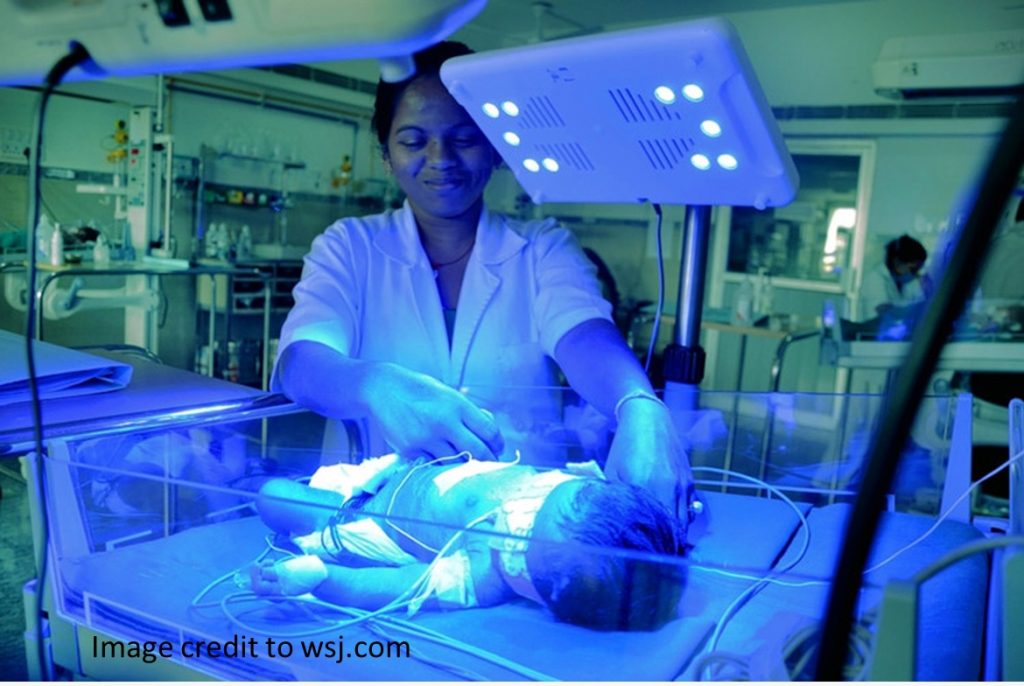
Almost all pre-term and even over 60% of normal birth babies are known to show signs of jaundice in the first couple of days after birth. Phototherapy is the most commonly recommended treatment for hyperbilirubinemia or what is commonly known as jaundice (a condition with higher levels of bilirubin in the blood than normal).
-
What is Phototherapy treatment?
Phototherapy is a treatment in the NICU that involves brief exposures of affected areas of skin, to light to reduce the concentration of bilirubin in the body of infants. Light sources could be any including daylight, fluorescent lamps, light-emitting diodes etc. Ultraviolet A (UVA) or ultraviolet B (UVB) are used to treat several skin and other problems. Earlier any light source with substantial UVA and UVB were used to treat newborn hyperbilirubinemia too.
Although daylight, fluorescent lights and others with UV radiations were effective in reducing bilirubin, they are not preferred now, due to possibility of sunburn in infants. Light in the blue spectrum wavelengths 460-490 nanometers (nm) is now found to be most effective and safer in phototherapy in infants for jaundice. The spectral wavelength of blue fluorescent bulbs is suitable to the absorption spectrum of bilirubin and has been used for long. However, most of the newer phototherapy units use Light-emitting diode (LED) lights. Blue LED lights also have a narrow spectral band of high-intensity light that overlaps the absorption spectrum of bilirubin. Studies comparing various light sources have concluded that LED lights are as effective as other conventional lights in reducing total serum bilirubin levels. Advantages of LED based phototherapy units include low power consumption, low heat production, and a much longer life span of the light-emitting units (10-20,000 hours) compared with older light sources. LED lights have no UV emission at all.
Visible light has wavelengths in the range of 400–700 nanometers (nm), or 4.00 × 10−7 to 7.00 × 10−7 m, between the infrared and the ultraviolet. Ultraviolet rays have wavelength below 450nm. The wavelengths between 450-495 nm belong to Blue light.
-
Why is phototherapy needed?
Newborn jaundice is the result of high level of bilirubin in the blood. Bilirubin is created by the body on replacement of old red blood cells. Due to high level of bilirubin baby’s skin and eyes may appear yellowish.
Normally the liver helps break down bilirubin so it can be removed from the body in the stool or urine. Before birth, feeding of the baby as well as removal of bilirubin from the baby’s body is taken care of through the placenta. After birth, the baby’s liver has to start processing this. It may take some time for the baby’s liver to be able to adjust and process this efficiently; hence high levels of bilirubin may occur briefly. This is more likely in pre-term infants.
-
How common or normal is jaundice or hyperbilirubinemia in newborns?
Jaundice in newborns is more common than you think. It is normal for a baby’s bilirubin level to be a bit high after birth. Jaundice or hyperbilirubinemia is likely to manifest in nearly all preterm infants and more than 60% of normal newborns. It is often most noticeable a couple of days after birth of the baby. Most of the time, it does not cause problems and gradually reduces over a period of 2 weeks or earlier.
Duration of phototherapy is generally recommended by the pediatrician based on age of the infant, current level of bilirubin and overall condition of the baby. In most cases, phototherapy will only be needed for 24-48 hours, in some cases, it may be required for 5 to 7 days.
-
What are the ways to reduce bilirubin or treat jaundice in infants?
There are three ways recommended starting from the simplest for mildest of cases to more difficult:
- Feeding – Feed the infant regularly and well. It is said that the baby must wet the diaper at least 6 times/ day and the stool colour should start changing from dark green to yellow. In general the baby must be well-fed, content and be taking in enough fluids to process the bilirubin on its own.
- Phototherapy – Expose maximum areas of the infant’s skin to light (except eyes), which helps expedite removing excess bilirubin. This is because light absorbed by the skin helps convert the bilirubin to an isomer which is more soluble in water and hence passed-away in the stool or urine faster than normal.
- Blood Transfusion – Is the last and extreme resort if no other treatment is working, since having high bilirubin levels for too long in the infant, may lead to brain damage.
-
What, if any, are the risks with or side effects of Phototherapy?
Phototherapy is most common and considered safer treatment. However, during phototherapy one needs to watch out for dehydration and skin rash/ burn in the baby and also monitor the baby’s temperature. Prolonged exposure to blue light has been known to cause retinal damage in adults. Although retinal damage from phototherapy using blue lights has not been reported, covering eyes for newborns during phototherapy is standard practice as a precaution.
PrimedeQ India is an e-Marketplace for medical equipment. We also offer many types of medical equipment on rental basis. We also offer phototherapy machine on rent in Bangalore and Hyderabad.
https://in.linkedin.com/in/shanthi-mathur-ab07838
